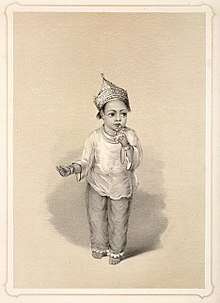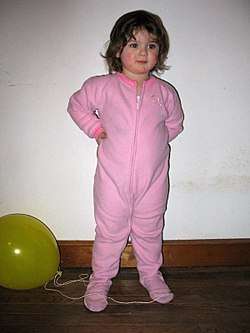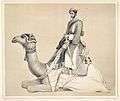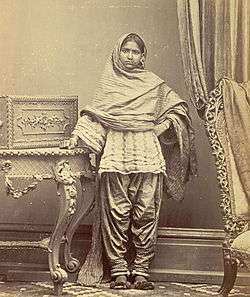Pajamas

Pajamas (US) or pyjamas (/pəˈdʒɑːməz,
The word pyjama[4] was borrowed c. 1800 from the Hindustani pāy-jāma (پاجامہ पाजामा), itself borrowed from Persian pāy-jāmeh پايجامه lit. 'leg-garment'.[5][6] The original pyjāmā are loose, lightweight trousers fitted with drawstring waistbands worn by many Indian Muslims, as well as many Sikhs and Hindus,[7][8] and later adopted by Europeans during British East India Company rule in India.[9][10]
History
The worldwide use of pajamas (the word and the garment) is the result of adoption by British colonists in India in the 18th and 19th centuries, and the British influence on the wider Western world during the Victorian era. Pajamas had been introduced to England as "lounging attire" as early as the seventeenth century, then known as mogul's breeches (Beaumont and Fletcher) but they soon fell out of fashion. The word pajama (as pai jamahs, Paee-jams and variants) is recorded in English use in the first half of the nineteenth century. They did not become a fashion in Britain and the Western world as sleeping attire for men until the Victorian period, from about 1870.[11]
Hobson-Jobson: A Glossary of Colloquial Anglo-Indian Words and Phrases (1886) summarizes the state of usage at the time (s.v. "pyjammas"):
Such a garment is used by various persons in India e.g. by women of various classes, by Sikh men, and most by Mohammedans of both sexes. It was adopted from the Mohammedans by Europeans as an article of dishabille and of night attire, and is synonymous with Long Drawers, Shulwaurs, and Mogul-Breeches [...] It is probable that we English took the habit like a good many others from the Portuguese. Thus Pyrard (c. 1610) says, in speaking of Goa Hospital: "Ils ont force calsons sans quoy ne couchent iamais les Portugais des Indes" [...] The word is now used in London shops. A friend furnishes the following reminiscence: "The late Mr. B—, tailor in Jermyn Street, some on 40 years ago, in reply to a question why pyjammas had feet sewn on to them (as was sometimes the case with those furnished by London outfitters) answered: "I believe, Sir, it is because of the White Ants."[12]
Types
Traditional
Traditional pajamas consist of a jacket-and-pants combination made of soft fabric, such as flannel or lightweight cotton.[13] The jacket element usually has a placket front and its sleeves have no cuffs.[14] Many people opt to sleep or lounge in just the pajama pants, either with a t-shirt, or, for males, barechested. For this reason, pajama pants for men and boys are often sold as separates.
In colloquial speech, these traditional pajamas are often called PJs, jim jams, or jammies.[15] In South Asia and South Africa, they are sometimes referred to as night suits.
Some pajamas feature a drop seat (also known as a trap door or butt flap): a buttoned opening in the seat, designed to allow the wearer to conveniently use a toilet. Drop seats were very common on pajamas made before the 1950s, but in the early twenty-first century they are rather rare.
Contemporary
Contemporary pajamas are derived from traditional pajamas. There are many variations in style such as short sleeve pajamas, pajama bottoms of varying length,[16] or, on occasion, one-piece pajamas,[17] and pajamas incorporating various materials. Chiefly in the US, stretch-knit sleep apparel with rib-knit trimmings are common. Usually worn by children, these garments often have pullover tops (if two-piece) or have zippers down the fronts (if one-piece), and may also be footed.
Although pajamas are usually distinguished from non-bifurcated sleeping garments such as nightgowns, in the US, they have sometimes included the latter as a top. Babydoll pyjamas have a kind of short dress top over shorts or short pants.[18]
Daywear
Pajamas may today refer to women's combination daywear, especially in the US where they became popular in the early twentieth century, consisting of short-sleeved or sleeveless blouses and lightweight pants. Examples of these include capri pajamas, beach pajamas, and hostess pajamas.[19]
Construction
Pajamas are usually loose fitting and designed for comfort, using soft materials such as cotton or silk or satin. Synthetic materials such as polyester and Lycra are also available.
Pajamas often contain visual references to a thing that may hold some special appeal to the wearer. Images of sports, animals, balloons, polka dots, flowers, stripes, plaids, foulards, paisleys and other motifs may all be used for decoration. Pajamas may also be found in plainer designs, such as plaid or plain gray, but when worn in public, they are usually designed in such a way that makes their identity unambiguous. Older styles of children's pajamas have been depicted as having a square button-up flap covering the buttocks.
Sociology
Pajamas are often worn with bare feet and sometimes without underwear. They are often worn for comfort by individuals in their living quarters. Since the late 20th century, some people, in particular those in the US and to some extent Britain and Australia, and Polynesians in New Zealand, have worn pajamas in public, whether for convenience or as a fashion statement.[20][21]
In January 2007, the gulf emirate Ras al-Khaimah (part of UAE) introduced a strict dress code for all local government workers in order to prevent them from wearing pajamas to work.[22]
In January 2010, the Tesco supermarket in St Mellons, Cardiff, United Kingdom, started a ban on customers wearing pajamas.[23]
In January 2012, a local Dublin branch of the Government's Department of Social Protection advised that pajamas were not regarded as appropriate attire for clients attending the office for welfare services.[24]
In January 2012, Michael Williams, a commissioner in Caddo Parish, Louisiana, proposed an ordinance prohibiting people from wearing pajamas in public. Caddo Parish already has a law against wearing sagging pants that hang below the waist. Williams pushed for a law against pajama pants after seeing a group of young men wearing loose-fitting pajama pants that were about to show their private parts. According to Williams, "The moral fiber in our community is dwindling. If not now, when? Because it's pajama pants today, next it will be underwear tomorrow." [25][26]
Williams’ concerns are reflected in many school and work dress codes. Mount Anthony Union High School in Bennington, Vermont, banned students in 2011 from wearing pajamas to school, concerned that they could be a safety hazard.[27]
Gallery
 Traditional men's pajamas.
Traditional men's pajamas. Girl in short-sleeve pajamas, doll in traditional.
Girl in short-sleeve pajamas, doll in traditional. Boys in stretch-knit pajamas.
Boys in stretch-knit pajamas. Toddler in footed pajamas.
Toddler in footed pajamas. Courier in white pajamas, India, 1844.
Courier in white pajamas, India, 1844. Men in white pajamas with hunting with cheetahs, India 1844.
Men in white pajamas with hunting with cheetahs, India 1844. Muslim men in pajamas (various styles), Bombay, 1867
Muslim men in pajamas (various styles), Bombay, 1867
 Hindu woman, in Sind, India, in shalwar-style pajamas, 1870.
Hindu woman, in Sind, India, in shalwar-style pajamas, 1870.
See also
References
- ↑ "'Moe' with owners James Davis & wife, in bed in children's pajamas, at home.", Life magazine, 1971, (Photographer: Ralph Crane).
- ↑ "Model clad in lounging pyjamas featuring peg-top trousers like jodpurs for sale at Neiman Marcus" Life magazine, 1939, (Photographer: Alfred Eisenstaedt)
- ↑ "Brazilian composer Heitor Villa-Lobos playing native Brazilian folk instrument from his collection, while wearing jacket over his pyjamas & smoking cigarette; at home." Life magazine, 1945 (Photographer: Unknown; Location: Rio De Janeiro)
- ↑ "Pyjamas".
- ↑ Volo, James M. (19 July 2012). The Boston Tea Party: The Foundations of Revolution: The Foundations of Revolution. ABC-CLIO. p. 51. ISBN 9780313398759.
The word pajama derives from the Hindustani epai-jama.
- ↑ Lewandowski, Elizabeth J. (24 October 2011). The Complete Costume Dictionary. Scarecrow Press. p. 216. ISBN 9780810877856.
pajama: (1930-1940 C.E. to present). From the Hindustani word epai-jama, shirt and trouser combination.
- ↑ Sharma, Sita Ram. Mohammad Ali Jinnah and Communal Leadership. APH Publishing Corporation. p. 93. ISBN 9788170249351.
Similarly, the sari is the most common dress of women all over India and is worn by both Hindu and Muslim women, and where pyjamas are worn by women as in parts of the north-western region, they are worn not only by Muslim women but by Sikh and Hindu women as well.
- ↑ Uttar Pradesh district gazetteers. Government of Uttar Pradesh. 1981. p. 100.
Hindu women in the towns usually wear sari and blouse, while the Jat, Sikh and other Panjabi women wear salwar, kurta and dupatta. In the urban areas, some elderly males, both Hindus and Muslims, are seen wearing churidar pyjamas, achkans (long, buttoned-up coats) and Gandhi caps.
|access-date=requires|url=(help) - ↑ Oxford English Dictionary 3rd edition, December 2007, s.v.
- ↑ Omoniyi, Tope (2016), The Cultures of Economic Migration: International Perspectives, Routledge, p. 228, ISBN 978-1-317-03654-8,
But under Muslim rule (in India) ... a variety of sown clothes started emerging .... Muslims introduced pyjamas and kurtas
- ↑ Lewis, Ivor. 1991. Sahibs, Nabobs and Boxwallahs: A Dictionary of Words of Anglo-India. Oxford: Oxford University Press. 266 pages. ISBN 0-19-564223-6. "They were introduced in England as lounging attire in the 17th century but soon went out of fashion. About 1870 they reappeared in the Western world as sleeping attire for men, after returning British colonials brought (them) back ...." Encyclopædia Britannica. Retrieved December 29, 2006, from: Encyclopædia Britannica Online.
- ↑ Yule, Henry and A.C. Burnell, Hobson-Jobson: A Glossary of Colloquial Anglo-Indian Words and Phrases (1886), s.v. Pyjammas, p. 748. Hobson-Jobson glosses "white ants" as "The insect (Termes bellicosus of naturalists) not properly an ant, of whose destructive powers there are in India so many disagreeable experiences, and so many marvellous stories."
- ↑ "Girl sitting on bed and wearing striped flannel pajamas and Disney Donald Duck slippers." Life magazine, December 1949, (Photographer: Nina Leen).
- ↑ "Millionaire Charles Ponzi posing for photograph in pyjamas." Life magazine, 1942, (Photographer: Hart Preston).
- ↑ "Three college students wearing their PJs and playing in the bunk bed of their dorm room during rush week at the University of Illinois", Life magazine, September 1956 (Photographer: Grey Villet).
- ↑ "Harriet Traynham (R) and her guests still wearing their pyjamas at 3:15 pm," Life magazine, August 1951 (Photographer: Lisa Larsen)
- ↑ "Actress Dorothy McGuire doing morning exercises wearing silk pajamas." Life magazine, 1941, (Photographer: Alfred Eisenstaedt)
- ↑ "Cynthia Brooks standing with her mother who is making alterations on her 'baby doll' pajamas", Life magazine, March 1957, (Photographer: Peter Stackpole)
- ↑ "Czech model posing in hostess pajamas." Life magazine, 1968, (Photographer: Bill Ray)
- ↑ "Now they're shopping in pyjamas in Shanghai!" Liverpool Echo, 17 January 2009. Retrieved 1 May 2015.
- ↑ Helen Pidd. "Tesco bans shopping for bananas in pyjamas ... or bare feet". the Guardian.
- ↑ "BBC NEWS - Middle East - Pyjama ban for UAE civil servants".
- ↑ "Tesco ban on shoppers in pyjamas". BBC News. 2010-01-28. Retrieved 2013-01-23.
- ↑ "Meanwhile, In Blanchardstown". Broadsheet.ie. 2012-01-24. Retrieved 2013-01-23.
- ↑ "Louisiana Official Moves to Ban Wearing Pyjamas in Public" Courtney Subramanian. Retrieved April 15, 2012
- ↑ "Pyjamas in Public a Real Crime? | NBC 5 Dallas-Fort Worth". Nbcdfw.com. 2012-01-17. Retrieved 2013-01-23.
- ↑ "Vt. high school dress code now bans pyjamas" Retrieved on April 15, 2012
External links
| Wikimedia Commons has media related to Pajamas. |
| Look up pajamas in Wiktionary, the free dictionary. |
- Gao Yubin, The Pyjama Game Closes in Shanghai. New York Times. May 14, 2010. Accessed May 18, 2010.